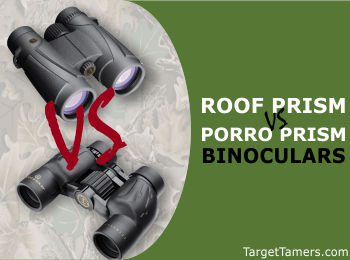
If you're a guy or gal who has a "type", you might be perceived as being shallow. But, in the optics world, that preference will certainly help you in the buying process.
And, when you're right in the middle of shopping for that one, perfect binocular, the first part of the elimination process will have you asking yourself something like "roof prism or porro prism?".
If you can arm yourself with everything there is to know about the two prisms, you'll be able to make the best binocular buying decision of your life... And, perhaps it'll be the one binocular that you can really settle down with for the rest of your hunting days.
In this article we'll help you determine the differences between the two prisms and which one could potentially be for you. And, since you can't really talk about prisms without talking about glass, we'll get into glass types too.
But, first off...
Why Prisms At All?
You'd think that when you looked through binoculars, you'd be able to see your image without anything too fancy going on behind the lenses right? I mean, binoculars are also kids toys, there can't be much to it? Well...
Without prisms, you would have an image that would be backwards and upside down. I don't even know what that would look like - a whole mess of a view if you asked me.
Prism assemblies correct the orientation of the image so that you view it the right way up and facing towards you. This is why technically they're called "erecting prisms".
Now, how the prisms are put together are where roof and porro come into play.
Porro Prism Binoculars
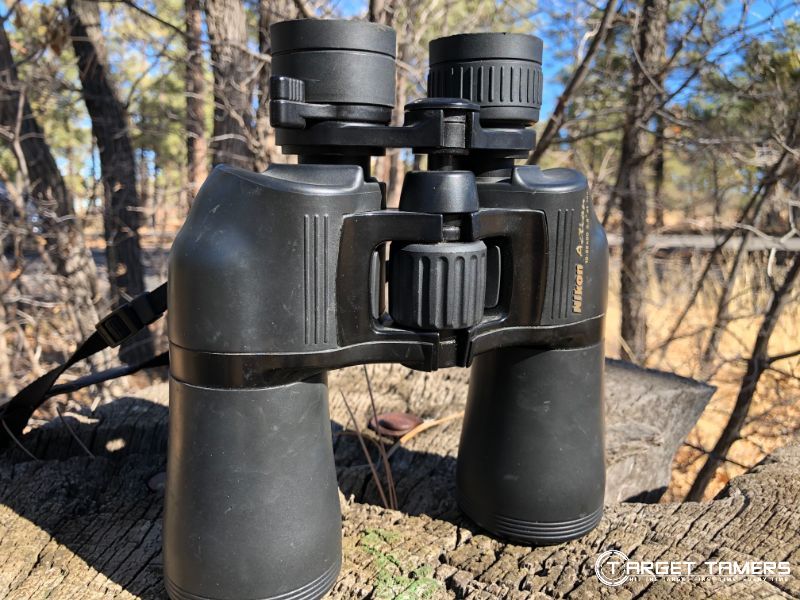
These types of binoculars have the more iconic and traditional binocular design, and they've been named after the Italian inventor Ignazio Porro. Additionally, there are actually two types of porro prisms: the standard porro and the reverse porro.
Standard Porro Prism: The standard porro prism system has offset eyepieces to objective lenses. The eyepieces are closer together while the objective lenses are further apart.
Reverse Porro Prism: The reverse porro prism system also has offset eyepieces to objective lenses. Instead, the eyepieces are further apart while the objective lenses are closer together.
How Do Porro Prisms Work?
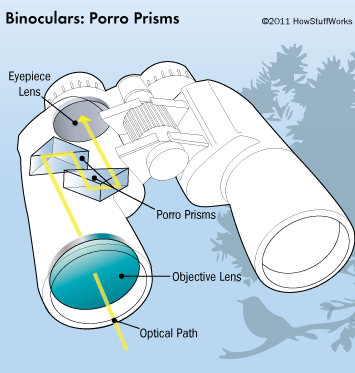
Porro prisms incorporate an optical path that directs light in a Z or zig zag-like pattern.
All surfaces in a porro prism binocular are completely internally reflective. This means if optical coatings and light transmission are the best, there will be no light loss.
Light-waves in a porro prism are only reflected off surfaces a total of four times.
To sum it up - light comes in through the objective bell, is directed through the reflective porro prism system in a Z pattern with four reflections to bring the image upright and forward to reach your eye.
Since light-waves are "folded", this explains why there needs to be that wide and offset construction in a porro prism binocular.
The wider and set-apart objective lenses are actually what helps with creating that stereoscopic image where you have a 3D-like, rich depth of field.
Benefits of Porro Prism Binoculars
- All internal surfaces are reflective - no light loss due to prism system
- Only four reflections in porro prism limiting further likelihoods of light loss
- 3D-like and rich depth of field
- Cheaper to manufacture and therefore, lower cost for consumer
- Can spend the same amount on a mediocre roof prism bino for a high-quality porro prism
- Basic optical quality is superior to roof prism bino
Drawbacks of Porro Prism Binoculars
- More difficult to weatherproof
- Typically bigger and bulkier than roof prisms
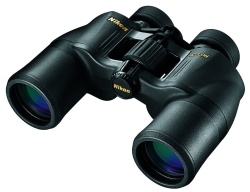
Porro Prism User Recommendations:
- Hunting
- Bird Watching
- Wildlife Observing
- Sporting Events
- Hiking
Porro prism binos are excellent tools for all outdoor activities, but just beware, you won't want to be caught out in less than ideal weather.
TIP: Hunters on a budget might want to upgrade to a high-quality porro prism binocular rather than spend the same amount on a mediocre roof prism binocular.
Roof Prism Binoculars
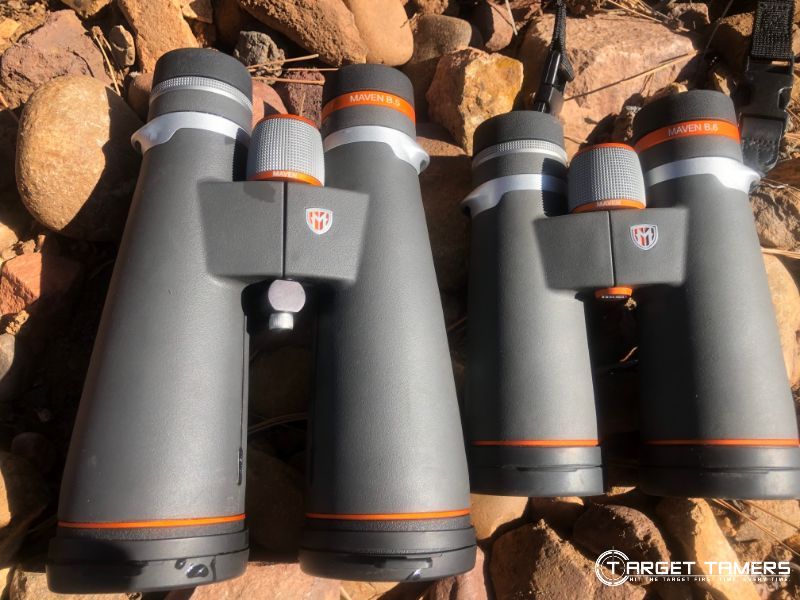
Roof prisms are named for the assembly's roof shape. You may have heard roof prisms also called as Dach prisms.
Here's a little language tidbit for you - Dach means roof in German.
And, if you know anything about optics and glass, it's that Germans certainly have a solid footing in the optics industry.
Now, there are a few variations of the roof prism design. There is the:
- Abbe-Koenig
- Schmidt-Pechan
- Amici
Essentially, they all maintain the same basic function - to keep light-waves entering and exiting the binocular in a straight line.
This is why roof prism binoculars have an aligned eyepiece-to-objective lens construction.
But, light-waves may take a little bit of a different route within the optical path of the roof prism assembly with the different roof prism variations.
How do Roof Prisms Work?
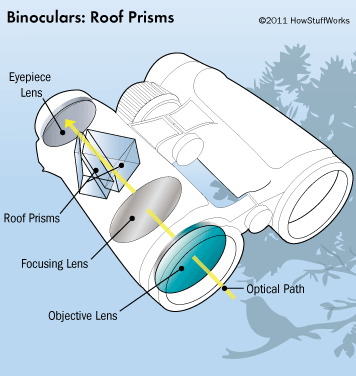
Light-waves reflect off the roof surfaces within the assembly a total of six times.
There are two prisms in a roof prism assembly.
The first prism has one surface that has no internal reflective qualities. To fix this, it needs to be applied with a special coating such as a mirror coating in order to raise its reflectivity to limit light loss.
The second prism has a point where the light reflects off an edge that requires manufacturers to use advanced technology to reduce chromatic aberrations such as color fringing and double vision. To fix this, usually a phase-corrected coating is used to keep light-waves in-phase.
To sum it up - light enters in the objective bell through to the two prisms in the roof assembly. The light path is leads through a course of six reflections to produce a horizontally and vertically erect image. Light then exits the binocular through the eyepiece in the same straight line that it entered the objective bell.
Since all of this happens in a straight line, this explains why you can have a more compact, streamlined, and weatherproof binocular.
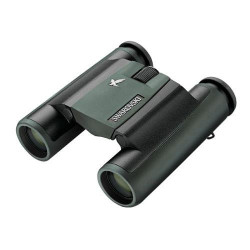
Benefits of Roof Prism Binoculars
- Can be optically superior to porro prisms with quality phase-corrected and mirror coatings
- Streamlined and sleek look is more attractive than porro prisms
- Lighter weight and more compact build
- Easier to weatherproof
Drawbacks of Roof Prism Binoculars
- Requires advanced technology to manufacture
- Is more expensive than porro prism binoculars
- Requires more internal reflections with higher chance of light loss
- The best roof prism binoculars will be very pricey to get the best technology and coatings
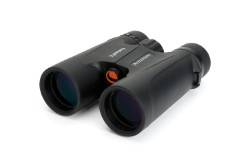
Roof Prism User Recommendations:
- Hunting
- Bird Watching
- Wildlife Observing
- Sporting Events
- Hiking
They're ideal for almost all types of outdoor enthusiasts because they're often compact, lightweight, and fully weatherproof.
TIP: To really get the optical benefits of roof prism binoculars, you'll want to spend on the pricier end for quality coatings and the technology used to ensure in-phase light-waves to reduce optical aberrations.
Glass 101: BK7 vs BAK4
There's a lot of confusion when it comes to glass, so let's clear up the scene with a basic glass 101 lesson. Why?
Just as important as prisms are in binocular function, so is the type of glass that the prisms are made out of. The glass has to go through processes such as grinding and polishing to ensure a sharp, clear, and bright image.
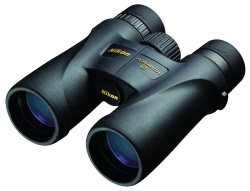
There's a lot of pressure on glass to perform optimally. They need to:
- produce a correct oriented, erect image
- allow as much light in as possible
- maintain in-phase light-waves
- be as reflective as possible
- prevent as much light loss with each reflection as possible
- transmit as much light to the edges of the field of view as it can
All of this just so that you can see that once in a lifetime trophy or the rare bird that you traveled miles away for at 4 A.M. in the morning.
This brings us to types of glass elements that are sometimes included in making your image perfect.
ED Glass
Extra-Low Dispersion or low dispersion glass provides High Density and High Definition images because it keeps light-waves in-phase, from bending, and from producing various types of aberrations.
Eco-Glass
This is when the actual glass is made without toxic chemicals such as lead and arsenic. When you go to toss your binoculars, if you ever have to, you know that you're not contributing to chemical pollution.
Now, back to BK7 & BAK4...
Too many times you will find misinformed buyers that think BK7 and BAK4 are prism assemblies instead of the glass that the prisms are made out of.
So, let's go over what exactly these mysterious elements seem to be.
BK7 Glass
BK7 is a term designated by Schott AG (a German authority on glass worldwide). It's made out of borosilicate (crown) glass, and it's highly reflective with a refractive index rate of 1.5168.
Myth: BK7 glass is only found on porro prism binoculars.
Truth: BK7 is found on both porro prism and roof prism binoculars. They also help to keep costs low.
How to Identify BK7 Glass
- Hold up your binoculars to a bright background or light to view the exit pupil.
- Tilt the binocular on angles, in circles, in any direction to get a full view of the exit pupil.
- Identify the squarish, clear zone within the center of the exit pupil. You should also be able to notice the shadowy or gray cut-off edges of the exit pupil.
But, how will the cut-off zone of the square exit pupil affect you?
Now, you're asking the good questions! You're going to have a vignetting effect with darker viewing and color loss around the periphery of the edge of the field of view. This can get worse the wider field of view you have. But...
Pay attention to the exit pupil size. If your BK7 prism glass binocular has an exit pupil of 4 mm or larger, and you're primarily using it for daytime glassing, your pupils are only going to be open to really no more than 3 mm.
If your pupils are only taking in light between the clear and open part of the exit pupil, you're not going to be affected too much by the cut-offs of the BK7 exit pupil shape anyway.
If your pupils are dilated much wider than the exit pupil, say during low light conditions, the cut-offs and the vignetting effect will be an issue for you.
With all of this in mind, if you're considering a BK7 prism glass binocular, shop for one with a larger exit pupil.
Benefits of BK7 Glass
- High refractive index rate
- Most commonly used type of crown glass on binoculars
- More affordable than BAK4 prism glass binoculars
Drawbacks of BK7 Glass
- Squarish exit pupil with gray cut-off edges
- Slightly lower refractive index rate compared to BAK4
BAK4 Glass
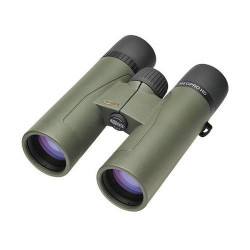
BAK4 is another term coined by Schott, and it's supposed to stand for BaritleichKron which is Barium Crown in German. Barium is another type of crown glass, and it's highly reflective with a refractive index rate of 1.5688. As you can see, this is barely higher than the BK7 glass.
Myth: All binoculars with BAK4 prism glass is made from barium crown and is considered high-end.
Truth: Not all BAK4 prism glass is made equal.
Schott BAK4 is made from barium crown and has the refractive index rate mentioned above.
But, most of the time when you see BAK4 prism glass, the manufacturer doesn't tell you that it's Chinese-made BAK4 glass that's actually made out of phosphate crown glass.
Chinese-made BAK4 prism glass has a refractive index rate of 1.5525 - lower than the real BAK4 but still higher than BK7.
But, why is everyone so hyped up about BAK4?
The higher refractive index rate and the complete, circular shape of the exit pupil will mean more light will be transmitted to the entire field of view. This will mean brighter, color-rich, and sharper edges of your periphery.
Benefits of BAK4 Glass
- Higher refractive index rate
- Brighter edges of the field of view
- Circular shape exit pupil
Drawbacks of BAK4 Glass
- Can increase overall cost of the binocular
- Manufacturers don't offer distinctions between Schott BAK4 and Chinese BAK4
To sum things up - BK7 has acquired an undeserved rep of being only a low-budget glass source since BAK4 doesn't want to share the spotlight. But, the real differences between the types of glass used isn't a big deal unless you're using wide field of view binoculars with small exit pupils where the BK7 glass may not cut it.
Bonus Info: Binocular Glass Coatings
Not only is prism type, glass elements, and type of glass important about a binocular, the coatings can make all the difference. None of the information we've just covered would matter if you don't have the coatings to match the prisms or the glass.
What are Lens Coatings?
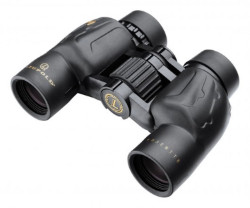
This is usually a proprietary formula that enables the lenses to allow a higher transmission of light-waves to reach your eyes. The way light behaves when it makes contact with the lenses is largely dependent on whether or not they've been treated with coatings and how many times it's been layered.
How to Define Binocular Coatings
- Coated - one single layer coating to at least one air-to-glass surface
- Fully-Coated - one single layer on all air-to-glass surfaces
- Multi-Coated - multiple layers to one air-to-glass surface
- Fully Multi-Coated - multiple layers to all air-to-glass coatings
But Beware...
There isn't a current industry standard to define multi-coated and fully multi-coated coatings.
You can have one manufacturer boast of having fully multi-coated coatings on a binocular but only apply it two to three times. Whereas, you can have another manufacturer applies 64 coatings to the lenses.
And, density and evenness of the layers are important in ensuring you have bright and clear views. Unless the manufacturer specially tells you about their coating process, you really can't distinguish between the quality of the coatings.
Don't Forget!
Roof prism binoculars need additional, specialized coatings and mirror coatings to be functional and optically on par with porro prism binoculars.
6 Final Tips to Choosing a Prism and Glass Type
With all of this information on what to look for in a binocular, it's hard to not feel overwhelmed. So, I've taken the initiative to act as match-maker. I've put together a few bonus tips to give you an idea of what to look for when scoping out your next beauty.
Tip 1:
Don't fall for the hype of BAK4 glass based on that alone. Although it has superior reflective and dispersion qualities versus BK7, you need to take into consideration coating quality, prism security, prism size, and other factors. You could do better with a BK7 that's securely housed with the right size prisms and excellent coatings. My point? - Consider the other quality factors also.
Tip 2:
If you want to spend the minimum amount of money possible on a binocular, a porro prism with BK7 glass is usually going to be the most economic buy.
Tip 3:
If you're convinced of a roof prism bino, plan to spend some decent cash for quality phase-corrected coatings. Without them, you may be able to get more bang for your buck with a porro prism binocular.
Tip 4:
Do you want a compact and lightweight binocular? - Roof prism. Do you not care much for size and weight? - Porro prism. Make sure to look at the specs - sometimes porro prisms aren't that much bigger or heavier than roof binoculars.
Tip 5:
When going with BAK4 glass binoculars and you want the best there is, double check that your optics manufacturer isn't using the Chinese-made BAK4. Check for European glass optics such as Carl Zeiss and Swarovski.
Tip6:
The Chinese-made glass isn't bad. Optical quality is still excellent and you can get a more affordable price than Schott BAK4 binoculars. Often times, highly reputable optics companies outsource their binocular manufacturing but they still require very strict quality control measures to be met by the foreign contractors.
Binocular Glass 101 - Done!
Now that you know everything there is to know, it shouldn't be too long now before there's a "save the date" event for your online purchase or your in-store buy. There's nothing more titillating than gearing up for your big day. Happy binocular hunting!
Ready to Shop? Check the Best Hunting Binoculars Here
Further Reading




Thanks for the well documented information. I'll be bino hunting for a holiday present and now I won't look too dumb or uninformed. Great article.
In the article is the statement that a roof prism "Can be
optically superior to porro prisms with quality phase correction and
mirror coatings."
Isn't this wrong? Porro prisms have no reflectivity
losses or phase shifting. Roof prisms have both problems . The coatings
are required to overcome the problems and approach perfect.
Porro prisms are already there.
Yes, you are correct that Porro prisms in their basic prism design is as perfect as can be compared to roof prism binos. However, the prism design is only part of the optical equation. If Porro prisms had the same amount of labor and engineering efforts as roof prism binos, Porro prisms would always be superior.
However, we know that hunters and bird watchers demand a waterproof, compact, and lightweight binocular, something that Zeiss and Leitz introduced in the 1960s with the roof prism binos. Since then, manufacturers have poured their efforts and money into perfecting the roof prism bino. While the roof prism design is inferior to the Porro prism in its basic form, roof prisms often have higher quality glass and stricter engineering controls versus cheap Porro prism binos.
While light loss and transmission rates are huge factors in optical quality, there are many other factors that allows a roof prism bino for possible superiority over a Porro prism bino. However, in the matter of a cheap roof prism bino versus a medium-grade Porro prism, yes the Porro prism is and will always be superior.
It's important to take into consideration all components of a binocular and especially the quality of materials used as expressed throughout the body of this article.
Bottom line, if you have less than $400 to spend, go with a Porro prism from a reputable company. If you have the luxury to spend more, an expensive roof prism bino offers just as good optical quality as a Porro prism but perhaps better glass (which lends to better optical quality), waterproofness, and compactness.
that was GREAT!! thank you....
Looking to get my wife set up for birdwatching and feel I can go forward armed with clear understanding now.
thanks again
Glad it was helpful. Thanks for your feedback!
Dude your report was a fantastic help I will be purchasing a Swarovski bino in few days.
Thanks again
Happy it helped. Enjoy your Swaro!
Great, thanks for this informatio!
Glad you liked it Roy! Thanks for the feedback.
Very good article thank you
Glad you liked it. Thanks for the feedback Pierre!